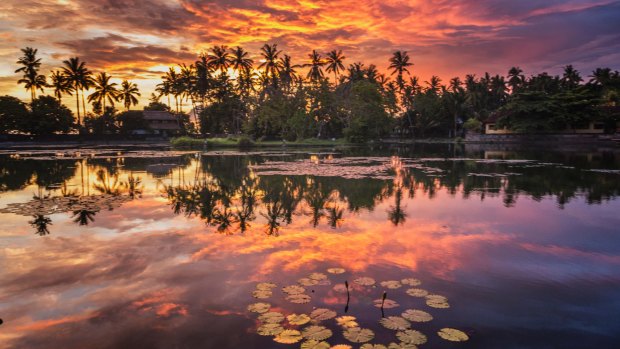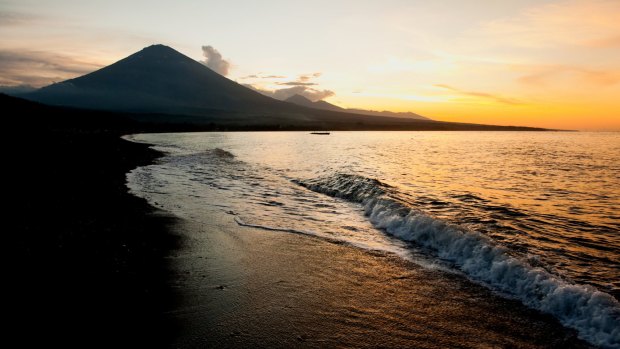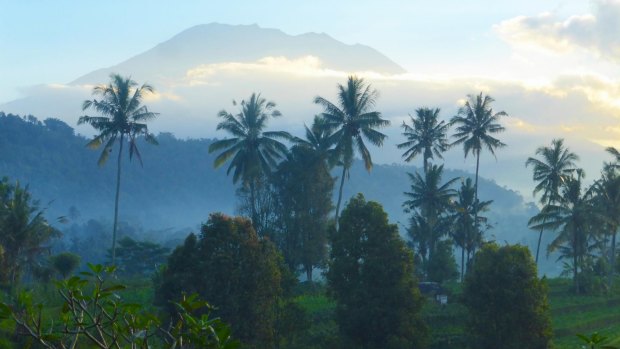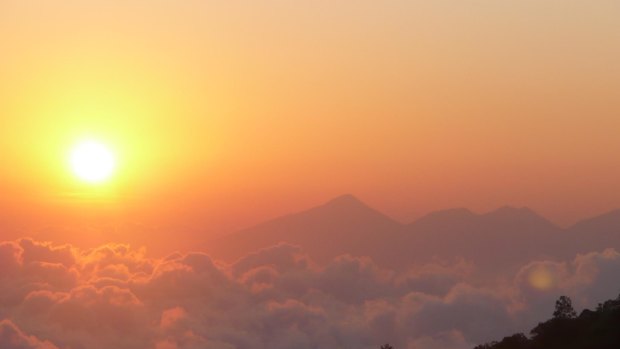
Silhouette of palm trees on the lake.Credit: iStock
Niluh Sriasil looks across her property, through her flame trees of blazing red and frangipanis of fairytale pink; past her fast-ripening mangoes out onto a crescent-shaped bay where the sea glints like a hundred camera flashes exploding at the same moment in the morning sunshine. She apologises quietly: "I'm sorry," she says. "We have no money for a swimming pool." Beneath us – where her front yard pitches into Lombok Strait – there's scarcely room for the three tiny bungalows she's built above a black-sand beach where jukung (traditional fishing boats) fill every spare centimetre of space, but she's embarrassed all the same she can't provide me with the fancy horizon pools that are the standard of every accommodation provider in Seminyak, Canggu or Uluwatu in Bali today. "I don't want a horizon swimming pool," I'd like to tell her. "I want what you have here: a beach with no-one on it."
But I know she won't understand what I'm trying to say; that many travellers to Bali are really just trying to find what they already had; before horizon pools and fancy ex-pat-owned cafes serving anti-oxidant shakes with cashew nut milk that cost the same as what they cost back home. Fancier hotel rooms, restaurants owned by celebrity chefs and swim-up pool bars don't make up for the fact many once-pristine beaches now teem with plastic, or for coach-loads of well-heeled Chinese tourists following guides with flags right through what used to be your secret surf spot.
So instead I sit looking out to sea from the eclectic restaurant she's assembled from shells, lava rock and bamboo here near Bali's most eastern point, and wait on a cup of strong black Bali coffee. I ask for a drinking coconut to chase it down with. She leans precariously off the edge of her pergoda, looks skyward, and apologises again: "I'm sorry, today we have no coconuts." And below this peaceful scene, life goes on much as it always has. Fishermen gather in groups after a morning spent at sea to slurp noisily at noodles, then they'll down their bowls to sort their catch, transporting the fish they won't feed their families to local markets. And a few kilometres inland, locals still till the soil of their rice paddy farms using water buffalo on the terraced foothills of Bali's largest mountain, the dormant volcano, Agung. Locals call it "the navel of the world".

The active volcano, Gunung Agung, looms large in the background of this sunset beach scene taken in Jemeluk, Amed, Bali.Credit: iStock
Chances are you've never heard East Bali spruiked as a tourist destination – or the towns that dominate it, like Amlapura, Candidasa and Tenganan. But it's here – an hour's drive east of the Eat Pray Love devotees in Ubud, and two hours journey north-east of the traffic jams in Seminyak, Legian and Kuta where you're most likely to find the Bali you came looking for: for it's that Bali of our collective imaginations; think: misty mountains, rice terraces spilling down hillsides, wild volcanic beaches. And except for the occasional European traveller (or ex-pat), there's barely a tourist to share it with. Despite the Australian annexation of Bali these past 30 years or so, few of us venture this far east. Many make it so darn close – just a few kilometres west of here to the port in Padangbai, to journey by sea to Lombok and the Gili Islands. I watch them motor past me each morning over breakfast at my pretty hotel by the sea.
Truth be told, I needed to find this place; because I've found myself outgrowing Bali. Or perhaps, if I'm really truthful, lately I'd noticed Bali's outgrown me. All around me, twentysomethings borrowed from Tommy Hilfiger catalogues whizzed past me on scooters between new age cafes and fancy ex-pat-owned bars; and cocktails came at me on lounge pods, by slick staff who took my change for tips. The surf spots I found in my late teens two decades or so on are now patrolled by locals sponsored by Billabong and Quiksilver. The leftovers are shared by surfers from every continent on this earth. It was a day trip I took quite by chance three years ago that made me consider East Bali as my antidote to the modern world, a place I might find what I loved here a quarter of a century ago. East Bali only demands a small effort by the traveller – it begins barely 1¼-hour's drive from the airport. I do battle with Seminyak-like traffic outside the tourist town of Sanur, but the road east soon narrows and the jungle grows right up above me, forcing me to drive through green tunnels of low hanging vines and trees in full bloom.
Bali metamorphoses here; like I'm time travelling. I manoeuvre around hair-pin corners, where locals bathe and wash clothes in slow-flowing rivers and fruit vendors peddle their wares – durian, mangos, bananas, snakefruit – centimetres from the roadway. Life in all its glory, and its tedium, happens here by the road: goods are traded, gods are blessed in tiny temples, children with hair slicked sideways trudge to school. Two cars can barely pass; when farmers carrying hoes and sickles and old men carrying logs to burn for cooking line the roadway, there's barely room for one.

East Bali is that image you had of Bali – all mountains, rice paddies and forest.
I drive high into the mountains inland from the village of Candidasa, near where my hotel is. The road slopes drastically now, we shift down gears fast along narrow ridges, teetering above huge green valleys. Farmers slash grass with machetes by the road to feed their buffalo; each tiny village is decorated with hanging vines and Hindu offerings. Petrol is sold in Smirnoff bottles where attendants sit on pink plastic stools eating bowls of hot rice. We stop here high among the clouds, and pull mountain bikes from our vehicle. Down narrow, winding, shaded mountain roads I coast through a Bali I remember well; teens on motorbikes follow close behind, while women carrying baskets of snakefruit on their heads disappear like ghosts in the mist behind the spindly bamboo fences at the road's edge. I stop to look out across an enormous green valley to Mount Agung. It last erupted in 1963, killing thousands. The huge chunks of lava left behind made much of the land difficult for farming for decades, and forced entire communities to flee to other parts of Bali, and beyond. It's why East Bali is still sparsely populated today, and partly explains why it's still not a major player in the tourism stakes.
I ride till we hit the beach, stopping at a semi-secret spot locals call Virgin Beach. There are beaches all along East Bali's coastline – though surfers who discover breaks here keep the locations to themselves. "This whole east coast of Bali is littered with unknown surf breaks, with amazing beaches, with pristine spots, you can't even see them on a map," long-time Bali surfer and co-owner of nearby surf resort, Kommune, Tony Cannon says. "You just have to turn off and have a bit of hope and see for yourself."
I find white sand at Virgin Beach after a laboured walk down a cobbled mud track to a tiny bay where the forest grows to the water. There's just a few simple warung (local restaurants) here, for now at least, all selling simple meals – grilled fish washed down with icy-cold Bintangs – a lunch for what a smoothie costs in Seminyak.

Mt Agung, Bali's tallest mountain, casts its shadow over most of East Bali Credit: Alila Hotels/Craig Tansely
Though East Bali is home to the prettiest rice fields in all of Bali, and thick green jungle creeps into every town here invoking a feeling that progress hasn't got a chance of scarring the landscape any time soon, not all of East Bali looks like a postcard. Its beaches are mostly of the black-sand variety, and on many you'd be hard-pressed to find a spot for a towel between the flotilla of jukung pulled up higher than the tide at every bay.
But I love to stare at the life on display here. In the tourist areas of Bali, I gain only an insight into the daily life in hotels, restaurants, cafes and massage parlours; but here just driving by provides me with a window into the traditional ways of a population largely unchanged by all of us. Sure, in towns like Amed and Candidisa I'm still offered taxis, motorbikes, boat trips and massages; but for the most part, I'm permitted to go by unnoticed, a harmless voyeur reliving the past.
I drive the slow, winding coast road to the diving hotspot of Amed, under the shadow of Mount Seraya. Women in colourful dresses walk beside the roadway, balancing baskets on the tops of their heads, while men carry fish on poles. Bananas, mangos and jackfruit grow so close I could pick them from my seat. The road zigzags constantly here, and we're forced to near walking speed travelling high above a rugged rocky coastline.
Life looks basic here: smoke filters out from wood fire stoves, cows, pigs and chickens are kept outside ramshackle wooden shacks, clothes are washed in rivers and hung beside the roadway on low-hanging branches. Around corners I can occasionally glimpse the huge caldera walls of Mount Agung, 3031 metres above the earth's surface, all around enormous lava rocks jutting from the earth are a constant reminder of the volcano's hold over those who live below it.
There's progress in evidence at Amed – 15 minutes drive beyond Niluh Sriasil's simple bungalows near the village of Jemeluk. But it's still of the low-key variety, and yoga (and diving) seems the currency here, it's peddled at quirky retreats alongside the roadside, backed by a hinterland of drastically sloping mountains and laden mango trees.
Some of Bali's most sacred temples can be found in East Bali (including the holiest of the holy, the Besakih Temple, and the sprawling royal water palace at Tirtigangga) but I'm much happier here avoiding the better known spots (where tourist buses do venture) to simply watch life play out around me. I'm quite content trapped here in my time capsule, an observer of a life much less hectic than the one going on in a Bali 40 years on from here, just an hour or so west.
TRIP NOTES
MORE
FLY
Jetstar (jetstar.com.au), Virgin Australia (virginaustralia.com.au) and Garuda (garuda-indonesia.com) fly to Bali daily from Sydney and Melbourne. Your hotel will organise a transfer, or a taxi will cost around $35 AUD.
STAY
Alila Manggis is a four-star hotel built on the shores of the Lombok Strait near Candidisa – it's one of the original luxury hotels in East Bali. They offer excursions deep into East Bali including the Mountain to Sea bike ride and an exploration of the east coast and the diving mecca of Amed. They also offer rafting, hiking and other activities. See alilahotels.com/manggis
Craig Tansley travelled at his own expense and with the assistance of Alila Hotels.
Sign up for the Traveller Deals newsletter
Get exclusive travel deals delivered straight to your inbox. Sign up now.